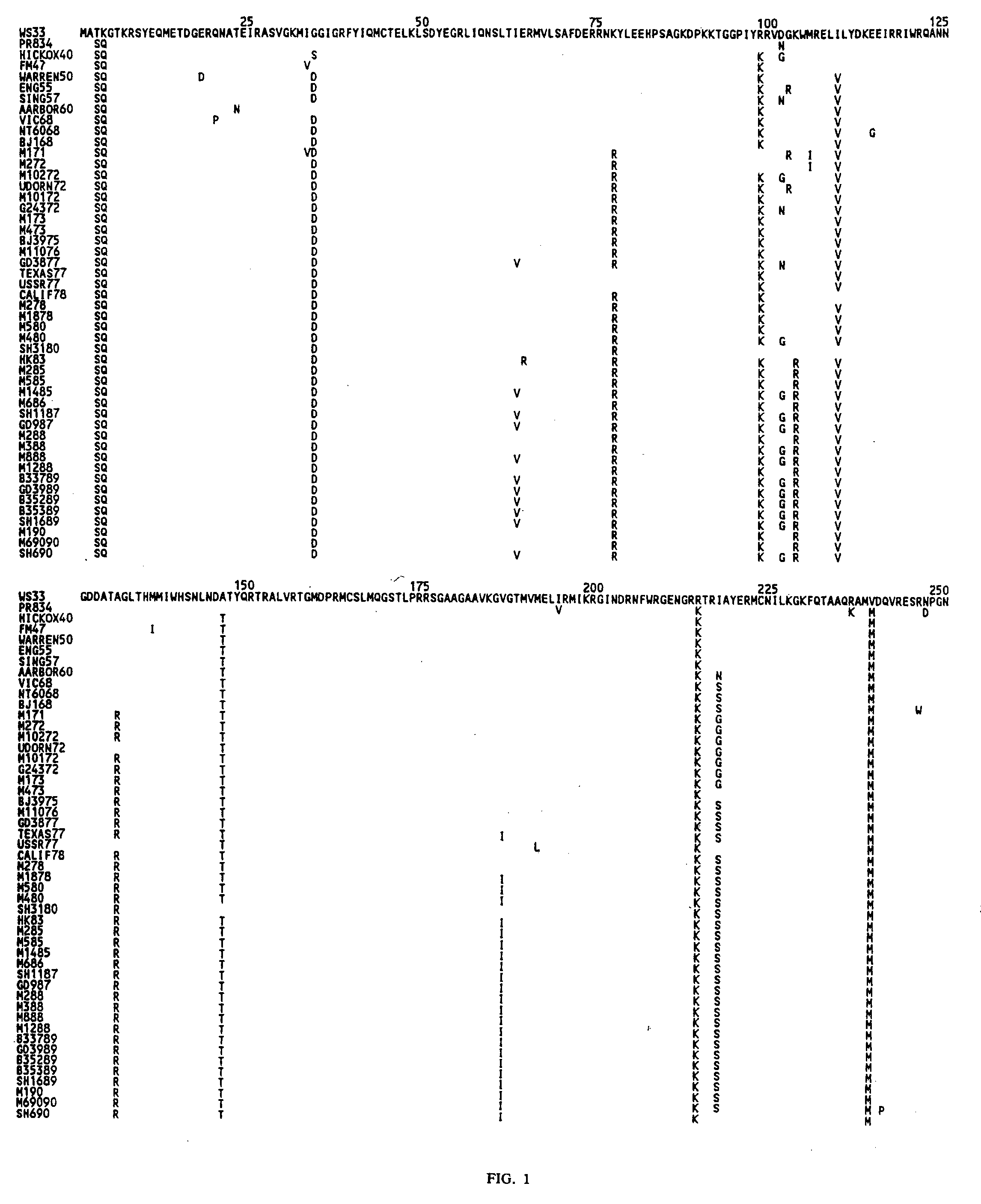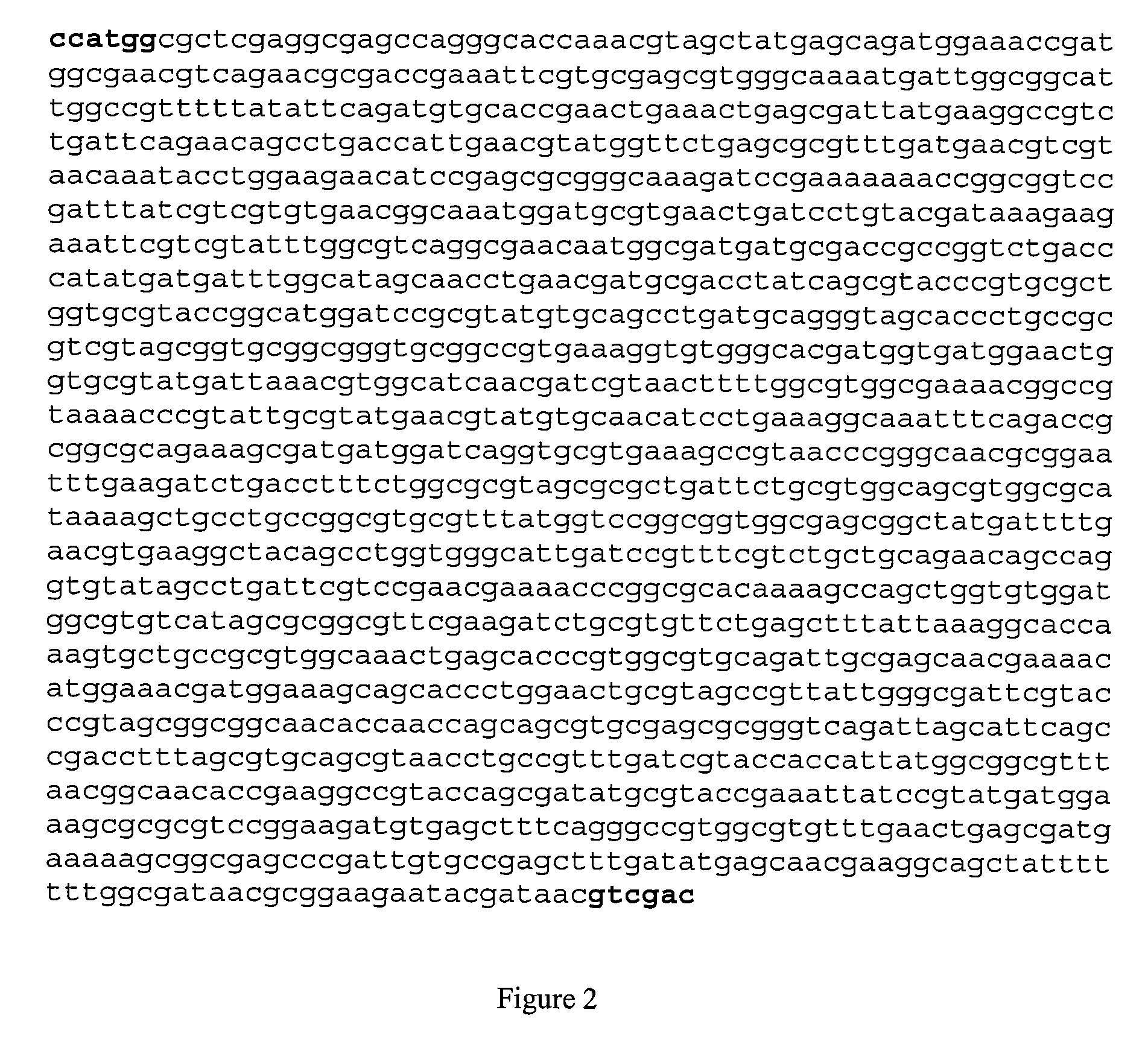Immunotherapy To Treat Or Prevent Viral Infection
- Summary
- Abstract
- Description
- Claims
- Application Information
AI Technical Summary
Benefits of technology
Problems solved by technology
Method used
Image
Examples
example 1
Production of NP Antigen
[0120]A cDNA encoding influenza nucleoprotein similar to that encoded in the A PR8 / 34 virus strain was designed for optimal expression in E. coli. Using the known amino acid sequence (see SEQ ID NO:2, above), the nucleotide sequence was changed for optimal codon usage in E. coli and also added restriction enzyme recognition sites at either end. Based on this deduced nucleotide sequence, cDNA was synthesized by GeneArt, with NcoI and SalI restriction endonuclease recognition sites incorporated in the synthesized product at the 5′ and 3′ ends, respectively (See FIG. 2, sequences In bold text). An alanine residue was also incorporated after the NcoI restriction site to encode a protein product in-frame with the 6× histidine tag in the expression vector. NcoI and SalI were used to digest the synthesized product as well as the pTricHis2C expression vector (Invitrogen Life Technologies), and the two products were ligated using a standard reaction. The ligation prod...
example 2
Active Immunization With NP
[0122]Mice were immunized with 30 μg recombinant nucleoprotein (rNP) in combination with 20 μg lipopolysaccharide on days 0 and 10 by intraperitoneal injection. An equal number of control mice were injected with LPS alone.
[0123]Serum was obtained 39 days after initial immunization to measure anti-NP antibody by ELISA. Briefly, peripheral blood was obtained from either euthanized mice by severing the renal artery and pipetting into a 1.5-ml tube or from live mice via the lateral tail vein. After clotting for 30 min at 37° C., the precipitate was pelleted in a microcentrifage, and the serum was collected. NP-specific ELISAs were performed by coating plates with 2 μg / ml rNP. Serum samples were diluted in 3-fold serial dilutions in PBS with 10 μg / ml BSA and 0.1% Tween 20 before incubation on coated plates. Bound antibody was detected with HRP-conjugated goat anti-mouse IgM or goat anti-mouse IgG (Southern Biotechnology Associates).
[0124]This immunization sched...
example 3
Protection After Active Immunization
[0125]In this example, in order to determine whether this NP-based vaccine could confer protection from an influenza virus challenge, the immunized mice were anaesthetized with isofluorane USP (Webster Veterinary) and intranasally (i.n.) infected with a non-lethal dose of influenza PR8 virus (500 EIU, ˜0.2 LD50) in 100 ml sterile PBS one month after the boost (day 40 after priming).
[0126]Mice immunized with LPS alone lost ˜15% body weight by day 7 post-infection, and had not yet recovered to their initial starting weight by day 11; by contrast, mice vaccinated with rNP / LPS lost less than 5% of their initial weight, and fully recovered by day 11 (data not shown). The reduced morbidity in rNP-vaccinated mice was associated with significantly lower viral titers in the lungs on day 8 after infection (FIG. 7). Therefore, as previously described, immunization of C57BL / 6 mice with rNP provides some measure of protection from sublethal challenge. Tamura e...
PUM
 Login to View More
Login to View More Abstract
Description
Claims
Application Information
 Login to View More
Login to View More - R&D
- Intellectual Property
- Life Sciences
- Materials
- Tech Scout
- Unparalleled Data Quality
- Higher Quality Content
- 60% Fewer Hallucinations
Browse by: Latest US Patents, China's latest patents, Technical Efficacy Thesaurus, Application Domain, Technology Topic, Popular Technical Reports.
© 2025 PatSnap. All rights reserved.Legal|Privacy policy|Modern Slavery Act Transparency Statement|Sitemap|About US| Contact US: help@patsnap.com



